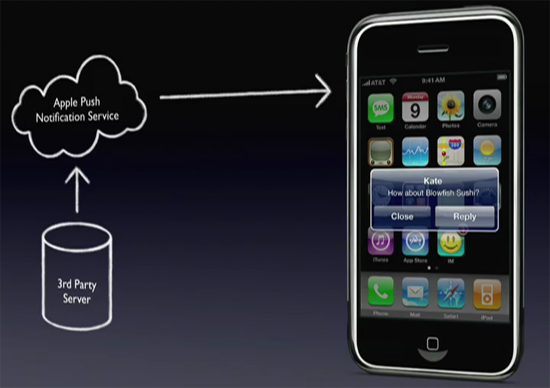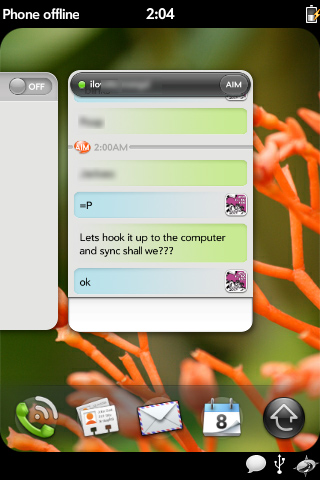Understanding the iPhone 3GS
by Anand Lal Shimpi on July 7, 2009 12:00 AM EST- Posted in
- Smartphones
- Mobile
The Inevitable Comparison: 3GS vs. Palm Pre
In response to my Pre review, many of you posted that the article read more like a comparison to the iPhone or a list of things for Apple to improve. I wrote it as such because I felt that while Palm out-innovated Apple in many ways, it fell short in just as many. At the same time I felt that Apple had much room to improve given the impact of the Pre, while also holding its advantages over the Pre. In short, neither device is perfect and both companies have much to learn from the other. It wouldn’t be fair for me to exclude the Pre from this article, as the iPhone 3GS delivers speed but lacks the functionality of what Palm has done with the Pre.
It’s a wonder what a year makes. Apple originally shied away from enabling background tasks on the iPhone because it didn’t want to compromise performance or battery life. The latter made sense, but the former didn’t really jive - the more we asked of the iPhone, the slower it got. In particular, its performance took a dive once the official App store launched along with the 2.0 firmware. Since then, the iPhone hasn’t exactly been fast - especially compared to some newer smartphones.
Apple’s solution to the background tasks problem was server-side push notifications. Take the most popular example: AIM. Since Apple doesn’t allow 3rd party applications to run in the background on the iPhone, if you’re in the middle of an AIM conversation and lock your phone, go to the home screen or launch another app, your connection to AIM is lost and your screen name logs off. You won’t get any new messages until you log back on.
 /
/
I love sushi
With the iPhone OS 3.0 the AIM app can use Apple’s push notification servers to keep the connection active. The minute you close the AIM app on the iPhone, the connection between your phone and AIM is severed but kept alive by one of Apple’s push servers. Any new messages that are to be delivered to your phone go to Apple’s servers, which know your phone’s IP and whereabouts. The servers then push the message to your phone and you see it like a SMS notification on the iPhone:
Sweet, right? It’s great for receiving a single message, but it’s horrible for actually maintaining a conversation. To respond to the message I have to click view message, then wait for the AIM app to launch and log me in and only then can I begin typing. Now let’s assume that I quit out of AIM because I had to do something else, or even worse, let’s assume that I left AIM because I had to send a text message. I’m now switching between two messaging apps to carry on two different conversations. It’s cumbersome.
As AIM messages pile up, the counter on my AIM app icon increments to let me know what I’ve got waiting for me.
Switching between apps is made much faster on the 3GS, this whole process is far more annoying on the 3G or original iPhone because actually launching the AIM app takes far longer. It’s a better overall experience but still no where near the seamless setup that Palm offers. If you mostly text/IM people on your phone, then honestly, forget the iPhone and get a Pre - Apple simply doesn’t do the best job here any longer.

Sending IMs and switching between apps on the Pre, the way it should be done
The iPhone OS needs a drastic revamp. The OS was designed very well for what the first iteration of the iPhone was created for: single tasking with SMS, email, web browsing, phone calls, music playback and browsing through photos. Add several pages of apps to the OS and try to multitask between them and the OS quickly shows its limits. Although Apple has added a very sweet Copy/Paste interface to the iPhone, that’s about the extent of how well you can work between apps thanks to Apple’s no background tasks limitation.
Palm got the implementation of a multitasking OS down right with the Pre, but the performance levels just aren’t up to snuff. Take using the dialer app for example. Animations are choppy and there’s a noticeable lag between when you tap a button and when the app responds. That just isn’t true of the iPhone and definitely not true of the 3GS; responsive is the key word here and Palm lacks it.
Unfortunately, what the 3GS has in responsiveness it lacks in productivity. The more I use the 3GS the more I wish I was able to run more than one application at a time. What I want is a phone that multitasks like webOS but with the speed of the 3GS. I believe that both Apple and Palm are capable of delivering such a device, I’m just unsure which company will do it first.










60 Comments
View All Comments
iwodo - Thursday, July 9, 2009 - link
Would really love Anand digg deeper and give us some more info. The info i could find for Atom, has 47 Million transistors. Ars report 40% of it is cache, while others report the core is 13.7 million. The previous iPhone article Jarred Walton commented that x86 decoder no longer matters because 1.5 - 2 million transistors inside a billions transistor CPU is negligible. However in Mobile space, 2M inside a 13.7M is nearly 15%. Not to mention other transistor used that is needed for this decoding.The space required for Atom is 25mm2 on a 45NM ( Including All Cache) . Cortex A8 require 9mm2 ( dont know how many cache ) on 65nm.
What is interesting is how Intel manage to squeeze the north bridge inside the Atom CPU ( more transistors ) while making the Die Smaller. ( i dont know if Intel slides were referring to the total package size or the die size itself ).
snookie - Thursday, July 9, 2009 - link
The Pre hardware, as in case, screen, keyboard is terrible. Cheap, plasticky and breaking left and right on people. If Palm survives long enough to get to Verizon etc Here's hoping they come out with better hardware soon. I've used Blackberries for year but I see no need for a physical keyboard. With the new iPhone widescreen keyboard I type with both thumbs very quickly and I have big hands.snookie - Thursday, July 9, 2009 - link
Jason, Apple has in fact agreed to using mini-usb as a standard. As if that is really a reason to buy a phone or not.To say Apple never changes shows no knowledge of the history of Apple, even their recent history.
Itaintrite - Wednesday, July 8, 2009 - link
Heh, it's funny how you say that you can't just look at clock speed, then followed with "the 528MHz processor in the iPod Touch is no where near as fast as the 600MHz processor in the iPhone 3GS." Heh.Anonymous Freak - Wednesday, July 8, 2009 - link
I want my punch and pie!Or a lollipop.
Good review, I could feel your hunger pangs toward both Palm and Apple toward the end...
monomer - Wednesday, July 8, 2009 - link
Regarding Anand's comments about Android phones needing an upgraded CPU, rumors are that the upcoming Sony Xperia Rachael will be sporting a 1GHz Qualcomm Snapdragon processor (ARM Cortex A8 derivative). Would love to find out the details of this phone when they become available.http://www.engadget.com/2009/07/04/sony-ericsson-r...">http://www.engadget.com/2009/07/04/sony...chael-an...
Affectionate-Bed-980 - Thursday, July 9, 2009 - link
Well I'd like to see Anand's experience with Android phones. What is it, just G1? Look at the new Hero or even G2. What about the Samsung i7500? Sorry I'm afraid that the limited nature of cell phone selection in the US makes it VERY HARD to review cell phones well here. I haven't seen a good cell phone site that's by people in the US and from the US only. Phone Arena, Mobile Burn, Phonescoop, GSM Arena, It seems the international guys get a LOT more exposure, and this is why I feel like Anand's comments about phones in general makes him sound inexperienced which I can certainly bet is the case.If you limit yourself to only carrier offered phones, then I don't think you can make accurate assessments about manufacturers like Nokia or certain OS phones like WinMo or Symbian or even Android unless the US starts offering more of what the world considers top notch popular phones.
Affectionate-Bed-980 - Wednesday, July 8, 2009 - link
N97 specs should be 434 MHz ARM11 not 424...Affectionate-Bed-980 - Wednesday, July 8, 2009 - link
BTW I don't believe you should be commenting about the N97. Gizmodo is heavily biased towards iPhones and unless you yourself Anand uses some Symbian S60 phones with detail, I don't really think you should join in the S60 bashing. I think a lot of us Symbian users AGREE that the platform needs to improve, but considering we were like ZOMG434MHZFAIL, the N97 is not bad in response time if you look at a few videos. The UI exceeded a lot of expectations amongst the Symbian crowd. If anything why don't you throw the Samsung i8910 Omnia HD in there instead? That has a Cortex A8 and uses Symbian S60v5 (not to mention has been out longer than the N97). The other S60v5 phone to come out is the Sony Satio which also uses a Cortex A8.You might as well comment on why Cortex A8 isn't being implemented in all new phones. WinMo phones are still on ARM11, and even HTC's newest announcements are ARMv7 chips. The iPhone doesn't define what high end is. Because if you want to point out that its unacceptable to have a ARMv7 chip in an N97, then it's just as unacceptable for the iPhone not to have a 5MP camera and multitasking.
straubs - Wednesday, July 8, 2009 - link
1. It IS unacceptable for any flagship phone to use ARM11. The iPhone, Pre, and Omnia HD (as you pointed out) all use it, so why wouldn't Nokia put it in it's $700 N-series flagship? It doesn't make sense. I'm surprised he didn't mention the crappy screen on the N97.2. He did comment on how the iPhone needs multi-tasking and how much he missed the Pre's implementation of it.
3. Doesn't everyone at this point agree that the number of megapixels in a phone camera is not a huge deal, considering the size of the sensor and optics? I would guess the N97 pictures are better than those from the the 3GS, but nothing like the jump from an ARM11 or A8.